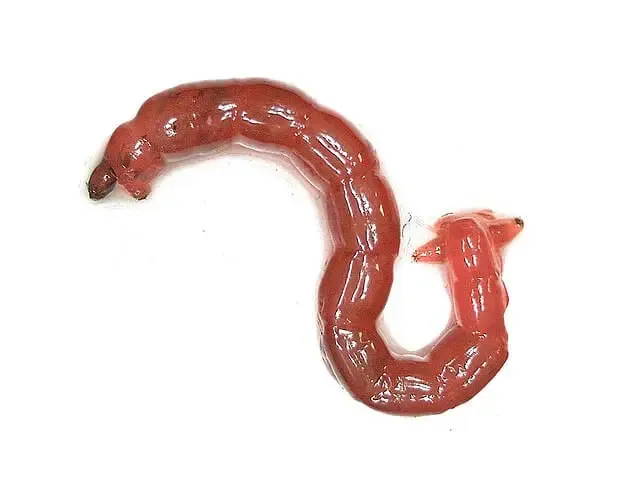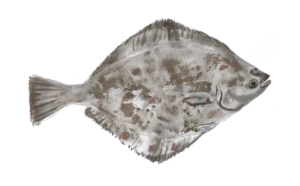Bloodworms are considered effective bait for fishing, especially for freshwater fish.
Bloodworms are the larvae of midges and are known for their reddish color and enticing wriggling motion, which attracts fish. The natural scent and movement of bloodworms in the water can trigger a feeding response in fish, making them more likely to strike.
Here’s my guide on how to fish with bloodworms as bait.
Are Bloodworms Good Fishing Bait?
Yes, bloodworms are excellent fishing bait. They are widely used and highly effective for attracting and catching various fish species in fresh and saltwater environments. They are particularly popular for freshwater species such as trout, bass, panfish, and catfish.
Bloodworms have a distinct reddish color and a wriggling motion that mimics live prey, attracting the attention of fish.
They are also rich in protein and other nutrients, making them an appealing fish food. The nutritional content of bloodworms can help entice fish to bite and increase the chances of a successful catch.
Bloodworms are commercially available at many bait shops and fishing supply stores. They are usually sold live or freeze-dried, making them convenient and easy to use as bait.
What Fish Love Bloodworms as Bait?
Both rainbow trout and brown trout love bloodworms. These fish are typically found in freshwater streams, rivers, and lakes and are known to have a keen sense of smell, making bloodworms an appealing choice for bait.
Panfish species such as bluegill, sunfish, crappie, and perch are often attracted to bloodworms. These smaller fish are commonly found in freshwater lakes, ponds, and slow-moving rivers.
Largemouth bass and smallmouth bass can be targeted using bloodworms. These fish are predatory and are known to strike at live prey, making bloodworms an effective bait option, particularly for smaller bass.
Catfish, both channel catfish and bullheads, have a strong sense of smell and are attracted to the scent and movement of bloodworms in the water.
Carp are known to feed on bloodworms, and using them as bait can effectively target these fish.
Where To Find Bloodworms?
If you want to buy bloodworms for fishing bait, check your area’s fishing bait and tackle shops. They are usually available in live or freeze-dried form. Some online suppliers specialize in providing live or freeze-dried bloodworms.
If you prefer to collect bloodworms yourself, you can try searching for them in areas with muddy or silty bottoms, such as marshes, swamps, or the shallow edges of lakes or ponds.
Some regions have commercial “bait digs” where individuals can collect their own bloodworms. These are typically areas where bloodworms are abundant, and you may need a permit to access these sites. Local anglers or bait shops in your area may be able to provide information about nearby bait digs.
How to Hook Bloodworms?
To hook bloodworms effectively, choose a fishing hook that matches the size of the bloodworms you are using and the fish species you are targeting. Generally, a small-sized hook, such as a size 6 to 10, works well for bloodworms.
Take a live or preserved bloodworm and hold it near the head. Insert the hook point into the head of the bloodworm, ensuring that it comes out through the body.
For smaller bloodworms or when targeting smaller fish, you can thread the bloodworm onto the hook until the hook point is covered and slightly protruding. For larger bloodworms or when targeting larger fish, you can thread the bloodworm fully onto the hook, covering the entire shank.
Regardless of whether you thread the bloodworm partially or fully, ensure that a small portion of the bloodworm is trailing behind the hook. This allows the bloodworm to move naturally in the water, attracting the attention of fish.
While securing the bloodworm on the hook is important, be gentle to avoid damaging the delicate bait. Bloodworms are quite soft.
How to Use Bloodworms as Bait?
Using bloodworms as bait is relatively straightforward. The way you present the bloodworm on your hook will depend on the fishing technique you’re using. For example:
- For bottom fishing: Allow the bloodworm to rest on or near the bottom. You can use weights or sinkers to keep the bait anchored in place.
- For float fishing: Attach a bobber or float to your fishing line above the hook, allowing the bloodworm to hang at a desired depth in the water column.
When fishing with bloodworms, noticing even the slightest fish bite is important. Once you notice a bite, respond quickly.
What Type of Live Bloodworms Are the Best Choice for Bait?
The two most common types of live bloodworms used as bait are:
- Red Midges (Chironomidae larvae): The larvae of midge flies and are often found in freshwater environments. Red midges have a distinctive red coloration, which is where their name comes from. They are a great fish attractant due to their natural movement and scent. They are also available at bait shops or can be collected from natural habitats.
- Glycera (Marine Bloodworms): Glycera bloodworms are typically found in saltwater water environments. They have a slightly different appearance compared to red midges, with a darker coloration and a larger size. Glycera bloodworms are often used for saltwater fishing, targeting species such as striped bass/stripers, flounder, and cod. They can be purchased from bait shops.

What Is the Best Way to Store Live Bloodworms?
Bloodworms should be stored in a cool environment. Ideally, the temperature should be between 38°F (3°C) and 45°F (7°C). Avoid exposing bloodworms to high temperatures, as it can lead to their rapid deterioration.
Bloodworms require a moist environment to stay alive and healthy. You can store them in a container or bait bucket with damp soil, peat moss, or newspaper. Ensure that the substrate is damp, not soaking wet, as excessive moisture can suffocate the live bait.
Bloodworms are sensitive to light and should be placed in a dark or dimly lit area. Use a bait bucket with a lid or cover the container with a dark cloth to protect them from light.
You should also regularly refresh the substrate and remove any dead or damaged bloodworms.
The Best Way to Store Preserved Bloodworms?
Here are some tips on storing dead bloodworms if you have leftovers from a fishing trip and want to preserve them for future use.
- Freeze Them: Place the dead bloodworms in a sealable plastic bag or an airtight container. Ensure minimal air is inside the bag or container to prevent freezer burn.
- Separate into Portions: If you have a large number of dead bloodworms, it’s a good idea to separate them into smaller portions before freezing.
- Label and Date: To keep track of the storage duration, label the bag or container with the date of freezing. This helps you use the oldest bloodworms first and ensures that you don’t keep them stored for too long.
- Thawing: When you’re ready to use the frozen bloodworms, allow them to thaw naturally at room temperature.
Sandworms Vs. Bloodworms for Fishing
Sandworms and bloodworms are both commonly used as bait in fishing, but they target different fish species.
Sandworms are popular for saltwater fishing and are effective for catching species such as striped bass, flounder, cod, and other marine predators. Bloodworms can also be used for saltwater fish species; however, they are more commonly used for freshwater fishing and are effective for targeting species like trout, panfish, and certain bait-loving freshwater fish.



